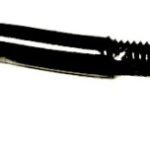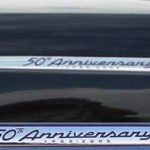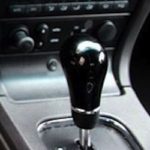In the seven years since I first wrote and published this article, there have been many developments to consider that impact your decision to buy a 2002-2005 Thunderbird. One of the most important considerations for those of you who are considering buying a ‘Retro’ Thunderbird, is the availability of replacement parts. Most of the OEM Ford replacement parts for the 2002-2005 Thunderbird are long out of production and have been ‘obsoleted’ by Ford. The few remaining parts are not only hard to find, but also considerably more expensive than they were in the past.
If you’re planning to buy a used Thunderbird now, be sure to factor in the parts scarcity and the higher costs of parts. The oldest of the 2002 Thunderbirds, many of which were actually manufactured in 2001, are now over 20 years old. That’s well past the typical ‘useful lifetime’ of most modern manufacture vehicles. And this applies to low-mileage Thunderbirds as well as higher mileage examples. Here’s why: Even if the Thunderbird you’re considering buying as relatively low-mileage, components deteriorate over time due to age, exposure to extreme temperatures, and contamination from pollutants and dirt and dust. This is especially true of electronic components such as the various electronic modules and the instrument cluster, which functions as an electronic module and communicates with the PCM (Powertrain Control Module), FEM (Front Electronic Module, also known as the ‘Lighting Control Module), and the REM (Rear Electronic Module). These modules are expensive to repair and replace, if you’re even able to find them. Other parts and components, such as the cooling system, suspension parts, CD changer, and Coil on Plugs (COPS), are also prone to failure, requiring expensive repairs.
So the decision to purchase a used 2002-2005 Thunderbird now, means both a financial commitment to repairs and maintenance, along with your willingness to deal with the hassles of taking the car to a Ford dealer or your local mechanic. Also prepare for delays waiting for parts.
But here’s the good news: First, many 2002-2005 Thunderbird are now priced below $ 10,000 … one-fourth of what they cost when new. Even lower-mileage examples are available in the $ 12,000-17,000 price range, making this car more affordable than ever.
Even better news is the future potential for this car. With only 68,098 built during the four model year production run, the 2002-2005 Thunderbird is a very low-production vehicle. In fact, the average annual production for the Retro Thunderbird, is about the same as the now-classic 1955-1957 Thunderbird, though it was only produced for three model years. The 2002-2005 Thunderbird is destined to become a classic collectible, joining the 1955-57 T-Bird, and later versions of this iconic automotive marque like the 1958-1960 ‘Square Bird,’ and the 1961-1963 ‘Bullet Bird.’ I firmly believe that very low-mileage, well-maintained and original 2002-2005 Thunderbirds to bring prices in the six-figure range within the next 10 or so years. Few modern-manufacture automobiles have that kind of potential upside in value. Consider that even an average, unrestored 1955-1957 Thunderbird is worth many times what it cost new. But the 2002-2005 Thunderbird would only have to increase in value roughly 2 1/2 times its original MSRP to be a six-figure car. Keep in mind though that only the best-maintained and lowest-mileage Thunderbirds will ever be worth $ 100,000 or more.
When shopping for a pre-owned 2002-2005 Thunderbird, as with any other used vehicle, requesting a CarFax history report is always a good idea. While CarFax reports won’t necessarily show all prior accidents or damage, it’s certainly a good place to start. Service and maintenance records are also a very good indication of how well a car has been cared for, and will show which repairs and/or replacements have been performed. As with any mass-produced car or truck, some are more reliable and trouble-free than others. Regular oil changes and other routine maintenance can help reduce costly repairs, but the possible need for future repairs are nearly impossible to predict. The overall appearance and visual condition of a car can provide some clue as to condition, however careful detailing can sometimes hide telltale signs of neglect or prior damage. A test drive is essential, and the longer the better. That may not always be possible with a private seller, but a reputable dealer may allow a prospective buyer to have an extended test drive or trial ownership period, during which a car can be returned if the buyer is unhappy. Such plans are not typical, but it does pay to shop around. Another very important factor to consider and to be alert for is any evidence of a ‘salvage’ title. A salvage title is typically issued when a car has been declared a total loss by the insurer due to a major collision, flood or fire damage. Some dealers specialize in buying salvage titled cars and restoring them prior to resale. While such cars may look good, it’s nearly impossible to assess how extensive hidden damage to mechanical and electrical systems on salvage cars may be. It’s usually better to pay more for a clean car with a clean title and a well-documented service history.
Next, check to see if the car has the OEM Soft Boot/convertible top cover. This factory accessory often becomes ‘separated’ from the car, stored in a garage or attic. This accessory is extremely difficult to find and is very expensive to replace. And it has not been available from Ford for over ten years. If the Thunderbird you’re considering doesn’t have the OEM soft boot, expect to pay anywhere from $ 1,000-2,000 or more, if you can find one. Many buyers of used Thunderbirds overlook this expensive accessory until it’s too late. The absence of this part may help you negotiate a lower price for the car. I highly recommend having the car inspected by a Ford or Lincoln dealer, or your own trusted mechanic. The best inspection is Ford’s own inspection, which is required for a used car to become a ‘Certified Pre-Owned’ vehicle. This comprehensive 172-point inspection covers functions and components you’re like to overlook. Be sure to check all interior and exterior lights, including the backlights of the instrument cluster. If you’re looking at the car in the daytime, you may not even think to check the instrument cluster lights. A defective instrument cluster can cause numerous problems, including a battery drain. And they are expensive to repair and rebuild.
Taking all this into account, the question remains: is now a good time to purchase a used 2002-2005 Thunderbird? The answer to this question depends on your personal reasons for considering one. I would not recommend one as a ‘daily driver. Due to the age and scarcity of parts, you should have another vehicle for everyday use. Of course, there are always exceptions. Some Thunderbird owners do use theirs on a daily basis and have put 100,000 or more miles on them. But if you’re looking for a distinctive and stylish, low-production car with future potential as a classic collectible, that is likely to increase in value, the 2002-2005 Thunderbird could be a good choice. Add to that the fact that the 2002-2005 Thunderbird is one of the few two-seat convertible American cars available today. Just be sure to factor in future repair and maintenance costs, along with the difficulty of finding replacement parts, and your tolerance for possible breakdowns, delays and loss of use while waiting for repairs and parts.
Many people who buy a 2002-2005 Thunderbird now, have wanted one since they first appeared on the market, but just couldn’t afford one. And with an MSRP of over $ 40,000, it was an expensive car at the time. Others have loved the Thunderbird since the first 1955-1957s. And the 2002-2005 is the first, and quite possibly the last, 2-seat convertible Thunderbird since the 1957.
I’m convinced that well-maintained Retro Thunderbirds will hold their value and even appreciate in value in the coming years. The low production numbers alone virtually guarantee that. Add to that its unique design and appeal, and the relative affordability, and you have even more reasons to consider one.
Ultimately, the decision is yours. But if you’re patient, and do your due diligence, you can minimize the risks and enjoy the benefits of ownership for many years to come!






